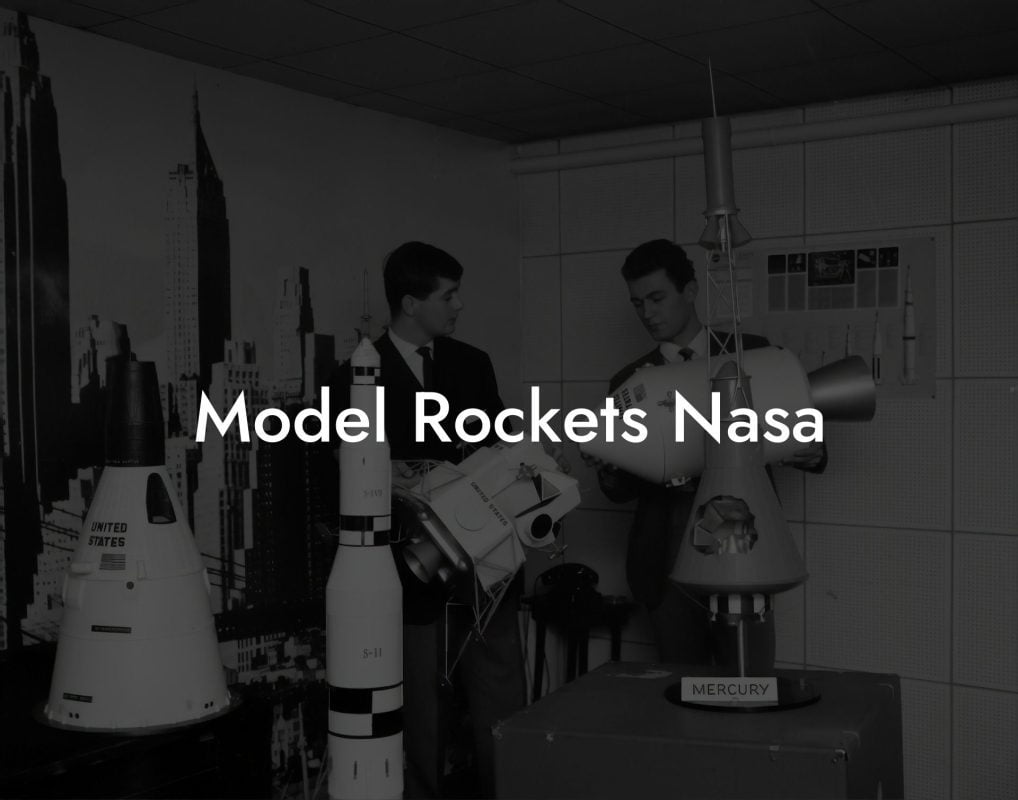Imagine soaring to new heights and exploring the thrill of space travel without leaving the ground. Welcome to the world of model rockets, where creativity meets innovation and adventure knows no bounds! Whether you're a seasoned enthusiast or just starting out, this comprehensive guide will walk you through the exciting process of designing, building, and launching your very own model rocket.
Quick Links to Useful Sections
What is a model rocket?
A model rocket is a miniature, self-contained vehicle designed to reach high altitudes and return safely to Earth. These incredible machines are powered by small motors, which produce a controlled burst of energy to propel the rocket upward. Model rockets can range from simple, beginner-friendly designs to complex, high-performance vehicles capable of reaching astonishing heights.
The beauty of model rocketry lies in its accessibility. With a few basic tools and materials, you can create your own rocket and experience the rush of launching it into the sky. Whether you're interested in science, technology, engineering, and mathematics (STEM) education, or simply looking for a fun and challenging hobby, model rockets offer endless opportunities for exploration and discovery.
The Essential Components of a Model Rocket
Before you start building, it's essential to understand the key components that make up a model rocket. These include:
- Nose Cone: The nose cone is the pointed tip of the rocket, designed to reduce air resistance and protect the payload during ascent.
- Body Tube: The body tube is the main structure of the rocket, providing a sturdy framework for the motor, payload, and recovery system.
- Motor: The motor is the heart of the rocket, producing the thrust needed to propel the vehicle upward. Model rocket motors come in various sizes and types, each with its own unique characteristics.
- Recovery System: The recovery system is designed to return the rocket safely to Earth after launch. This can include parachutes, streamers, or other mechanisms to slow the rocket's descent.
- Payload: The payload is the cargo carried by the rocket, which can include cameras, sensors, or other instruments to collect data during flight.
Understanding these components is crucial for designing and building a successful model rocket. By combining these elements in a thoughtful and creative way, you can create a rocket that not only flies high but also returns safely to Earth.
Looking For The Best Model Rocket Kits? You'll Love These:
Designing Your Model Rocket
With the essential components in mind, it's time to start designing your model rocket. This is where creativity meets innovation, as you bring your vision to life. Consider the following factors when designing your rocket:
- Stability and Aerodynamics: Ensure your rocket is stable and aerodynamic, with a balanced design that minimizes air resistance.
- Motor Selection: Choose a motor that suits your rocket's design and performance goals, taking into account factors like thrust, duration, and safety.
- Recovery System Design: Design a recovery system that can safely return your rocket to Earth, considering factors like parachute size, material, and deployment mechanisms.
- Payload Capacity: Determine the payload capacity of your rocket, ensuring it can carry the desired instruments or cameras safely and efficiently.
By carefully considering these factors, you can create a model rocket that not only looks amazing but also performs exceptionally well.
Building Your Model Rocket
With your design complete, it's time to start building your model rocket. This is where patience, attention to detail, and craftsmanship come into play. Follow these steps to bring your rocket to life:
- Cut and Assemble the Body Tube: Cut the body tube to the desired length and assemble the rocket's structure using glue, tape, or other adhesives.
- Install the Motor: Carefully install the motor, ensuring it's securely attached and aligned with the body tube.
- Add the Recovery System: Install the recovery system, including the parachute or streamer, and attach it to the rocket's nose cone or body tube.
- Integrate the Payload: Install the payload, ensuring it's securely attached and protected during flight.
- Final Assembly and Inspection: Complete the final assembly of your rocket, inspecting each component to ensure it's securely attached and functioning properly.
Building a model rocket requires patience, attention to detail, and a willingness to learn and adapt. By following these steps, you can create a rocket that's both functional and visually stunning.
Launching and Recovering Your Model Rocket
The moment of truth has finally arrived – it's time to launch your model rocket! Follow these steps to ensure a safe and successful launch:
- Choose a Safe Launch Site: Select a launch site with minimal obstacles, wind, and air traffic, ensuring a safe and controlled environment.
- Prepare the Rocket: Prepare the rocket for launch, ensuring all components are securely attached and functioning properly.
- Launch the Rocket: Launch the rocket, following safety guidelines and local regulations to ensure a safe and successful flight.
- Track and Recover the Rocket: Track the rocket's flight, using visual or electronic means to locate and recover it after landing.
Launching and recovering your model rocket is an exhilarating experience, requiring careful planning, attention to detail, and a sense of adventure. By following these steps, you can ensure a safe and successful launch, and begin planning your next model rocket project.
Troubleshooting and Maintenance
Like any complex system, model rockets can sometimes malfunction or require maintenance. Here are some common issues and solutions to keep your rocket flying high:
- Motor Failure: If your motor fails to ignite, check the igniter, wiring, and motor itself for damage or malfunction.
- Recovery System Failure: If your recovery system fails to deploy, inspect the parachute or streamer for damage, and check the deployment mechanism for proper function.
- Payload Damage: If your payload is damaged during flight, inspect the payload compartment and recovery system for damage, and consider redesigning the payload or recovery system for future flights.
By understanding common issues and solutions, you can troubleshoot and maintain your model rocket, ensuring it continues to perform at its best.
Resources and community Support: Your Next Steps
Congratulations on completing your model rocket project! As you continue to explore the world of model rocketry, here are some valuable resources and community support options to help you take your skills to the next level:
- Model Rocketry Clubs and Organizations: Join local or national model rocketry clubs and organizations, such as the National Association of Rocketry (NAR), to connect with fellow enthusiasts and learn from experienced modelers.
- Online Forums and Communities: Participate in online forums and communities, such as Reddit's r/modelrockets, to share knowledge, ask questions, and learn from others.
- Model Rocketry Books and Guides: Explore comprehensive guides and books on model rocketry, covering topics from design and construction to launch and recovery techniques.
- Local Hobby Shops and Suppliers: Visit local hobby shops and suppliers, such as Michaels or HobbyTown, to find model rocket kits, components, and expert advice.
By leveraging these resources and community support options, you can continue to grow as a model rocket enthusiast, sharing your knowledge and passion with others while exploring new heights.
Frequently Asked Questions: Model Rocketry 101
Here are some frequently asked questions about model rocketry, covering topics from safety and regulations to design and construction:
1. Is model rocketry safe?
Yes, model rocketry can be a safe and enjoyable hobby when practiced responsibly and within established safety guidelines.
2. What are the regulations surrounding model rocketry?
Regulations vary by country and region, but most model rocketry clubs and organizations adhere to guidelines set by the National Association of Rocketry (NAR) and the Federal Aviation Administration (FAA).
3. What is the best material for building a model rocket?
The best material for building a model rocket depends on the design and performance goals, but common materials include paper, plastic, wood, and composite materials like fiberglass and carbon fiber.
4. How do I choose the right motor for my model rocket?
Choose a motor that suits your rocket's design and performance goals, considering factors like thrust, duration, and safety.
5. What is the highest altitude a model rocket can reach?
The highest altitude a model rocket can reach depends on the design, motor, and recovery system, but some high-performance rockets have reached altitudes exceeding 100,000 feet.
Looking For The Best Model Rocket Kits? You'll Love These:
Useful Interruption: Dive deeper into the world of Model Rockets with our most popular sections. If there is anything you think is missing or anything you would love for us to write about, just give us a shout.
- Getting Started & Basics With Model Rockets
- Model Rocket Design, Build & Customization
- Model Rocket Propulsion & Engine Technology
- Model Rocket Launch Techniques & Recovery
- Model Rocket Advanced Rocketry & Innovations
- Model Rocket DIY and Customization
- Model Rocket Equipment Reviews & Digital Tools
- Community, Competitions & Education
- Model Rocket Troubleshooting & FAQs
- Model Rocket Bonus/Seasonal & Niche Topics
A group of model rocket enthusiasts gathered at a field for their weekly launch event. Among them was Dave, a seasoned builder known for pushing the limits of hobby rocketry. This time, he had outdone himself.
“Ladies and gentlemen,” Dave announced, dramatically pulling a cloth off his latest creation, “I present to you: The Kraken!”
The crowd gasped. This wasn’t just a model rocket, it was a monster. The thing stood 8 feet tall, had six clustered engines, and was covered in enough duct tape to qualify as a classified aerospace project.
“Dave,” muttered Steve, the cautious safety officer, “Have you, uh… done the math on this?”
“Math?” Dave scoffed. “I built it in my garage at 3 a.m. with parts from eBay. This is an art piece, Steve.”
The countdown began.
5…
4…
3…
2…
1…
The engines ignited with a BOOM, and The Kraken shot up… kind of. It immediately did a violent barrel roll, narrowly missing the spectators before skyrocketing at an angle that could only be described as “legally questionable.”
The crowd collectively ducked as The Kraken flew straight over the adjacent cornfield, where Old Man Jenkins, the grumpiest farmer in town, was minding his business.
KABOOM!
The rocket disappeared behind the barn. A moment later, a flaming piece of Estes igniter wire landed at Steve’s feet. The silence was deafening.
And then, an unmistakable sound echoed across the field.
Jenkins’ shotgun being cocked.
“DAVE!!!” Steve shouted. “RUN.”
And that was the day Dave invented the first-ever biologically powered rocket booster: pure adrenaline.
To this day, nobody knows where The Kraken landed, but legend has it, it still haunts the skies, terrifying unsuspecting drones and low-flying birds.















